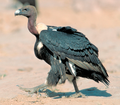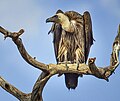| Genus | Common and binomial names | Image | Range |
|---|
| Necrosyrtes Gloger, 1841 | Hooded vulture
Necrosyrtes monachus |  | Sub-Saharan Africa |
| Gyps Savigny, 1809 | Griffon vulture
Gyps fulvus |  | Mountains in southern Europe, north Africa and Asia |
White-rumped vulture
Gyps bengalensis |  | Northern and central India, Pakistan, Nepal, Bangladesh and southeast Asia |
Rüppell's vulture
Gyps rueppelli |  | The Sahel region of central Africa |
Indian vulture
Gyps indicus |  | Central and peninsular India |
Slender-billed vulture
Gyps tenuirostris |  | The Sub-Himalayan regions of India and into Southeast Asia |
Himalayan vulture
Gyps himalayensis |  | The Himalayas and Tibetan Plateau |
White-backed vulture
Gyps africanus |  | Savannahs of west and east Africa |
Cape vulture
Gyps coprotheres |  | Southern Africa |
| Sarcogyps Lesson, 1842 | Red-headed vulture
Sarcogyps calvus |  | The Indian subcontinent, with small disjunct populations in Southeast Asia |
| Trigonoceps Lesson, 1842 | White-headed vulture
Trigonoceps occipitalis |  | Sub-Saharan Africa. Extinct populations have occurred in Indonesia. [7] |
| Torgos Kaup, 1828 | Lappet-faced vulture
Torgos tracheliotos |  | Sub-Saharan Africa, the Sinai and Negev deserts and north-west Saudi Arabia |
| Aegypius Savigny, 1809 | Cinereous vulture
Aegypius monachus |  | Southwestern and central Europe, Turkey, the central Middle East, northern India, central and east Asia |
| † Aegypius jinniushanensis | | Pleistocene of China |
| † Aegypius prepyrenaicus | | Pleistocene of Spain |













